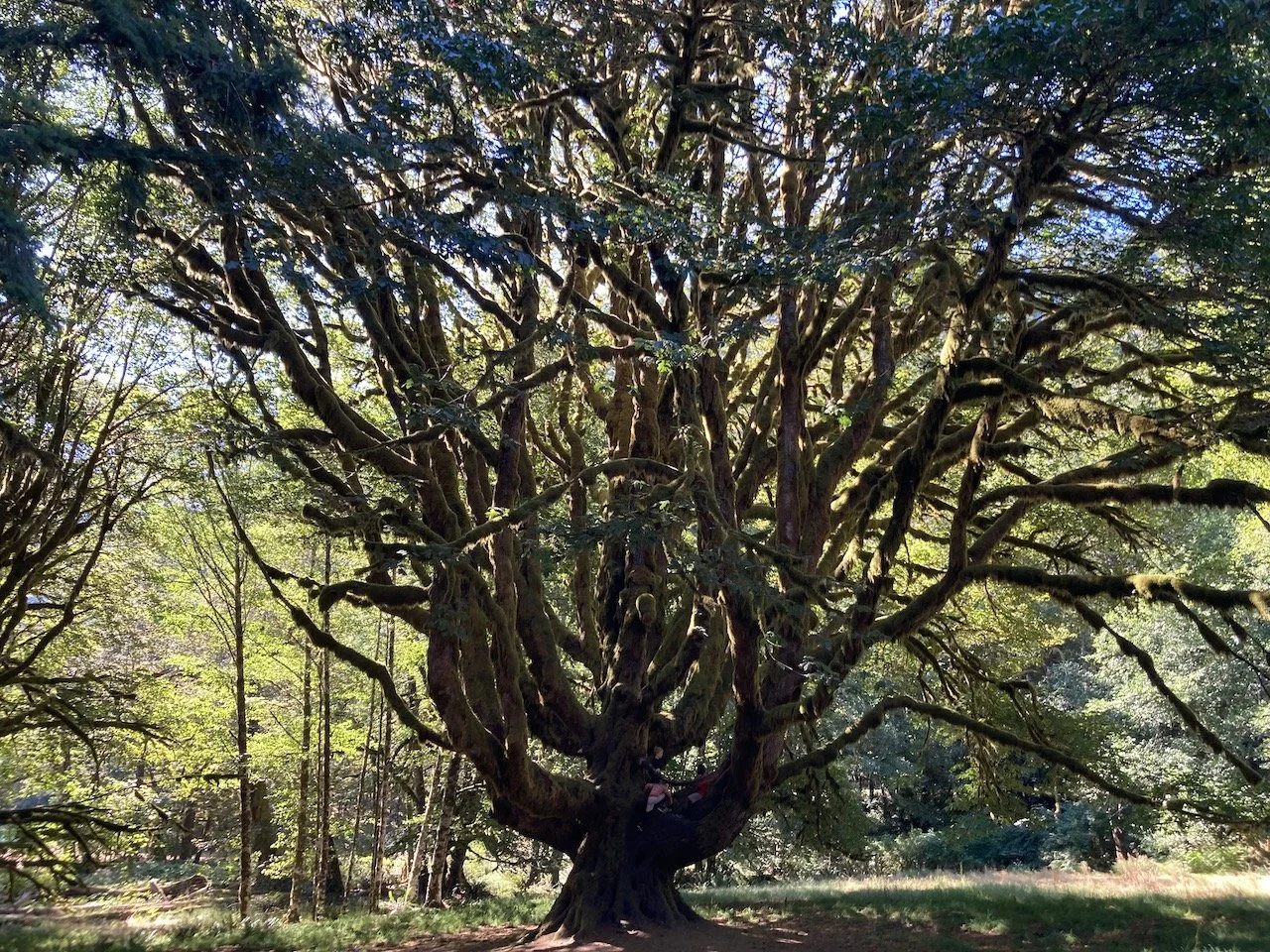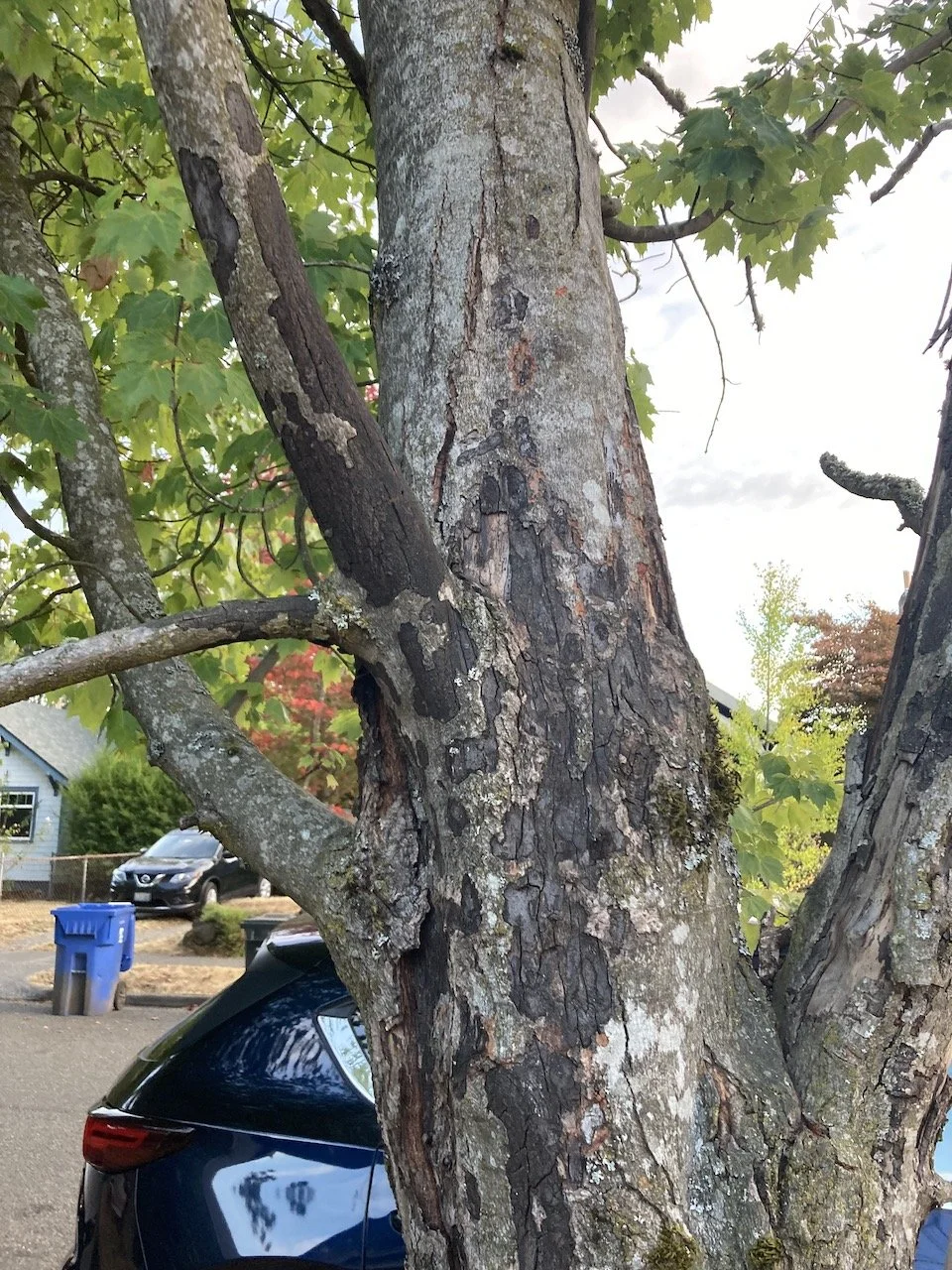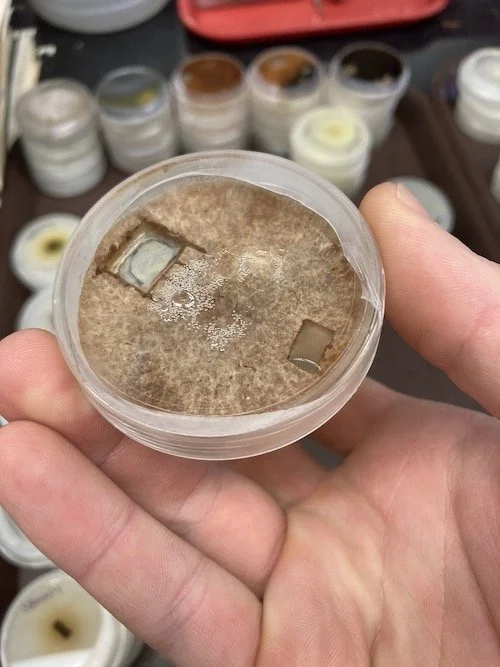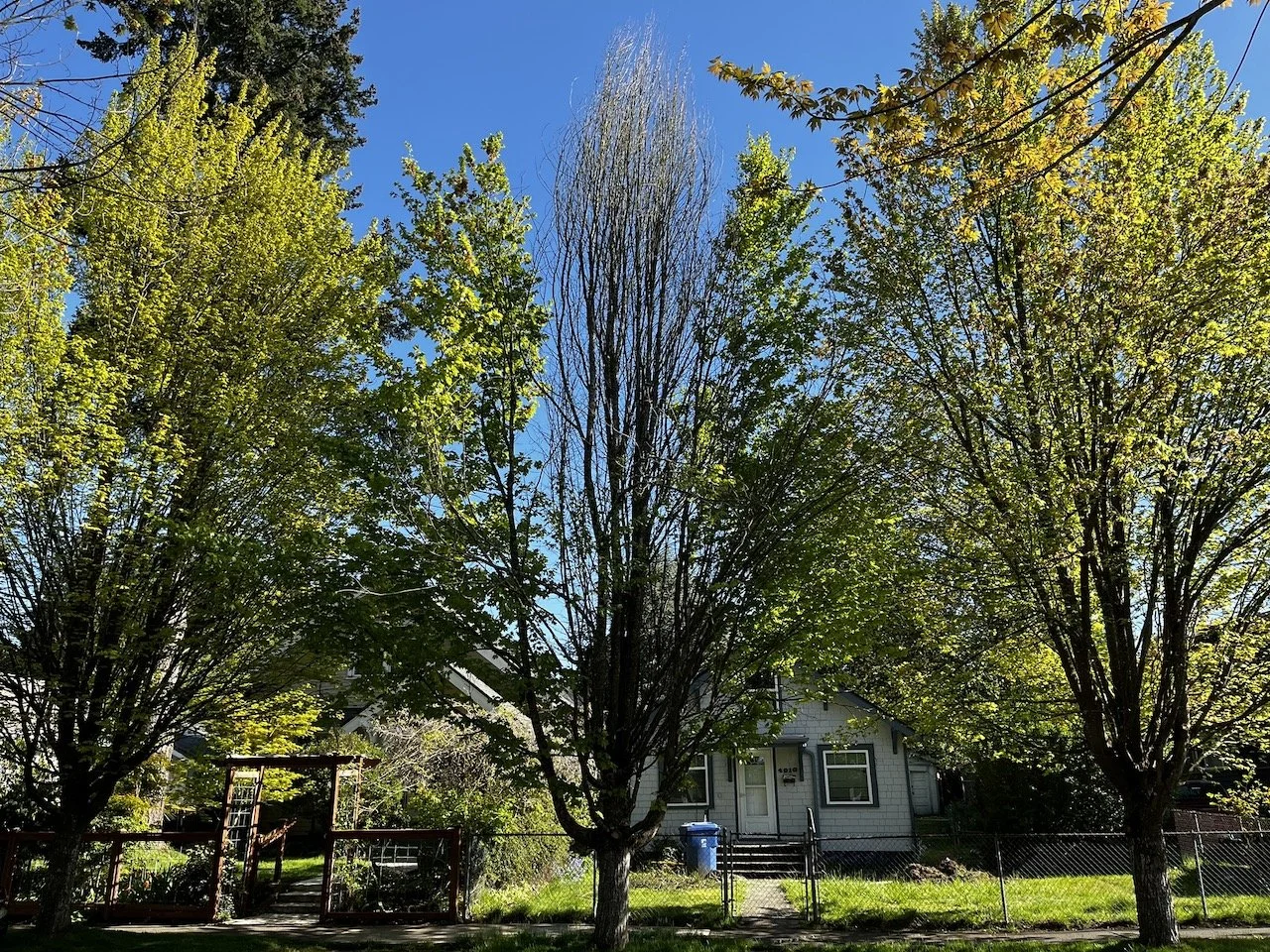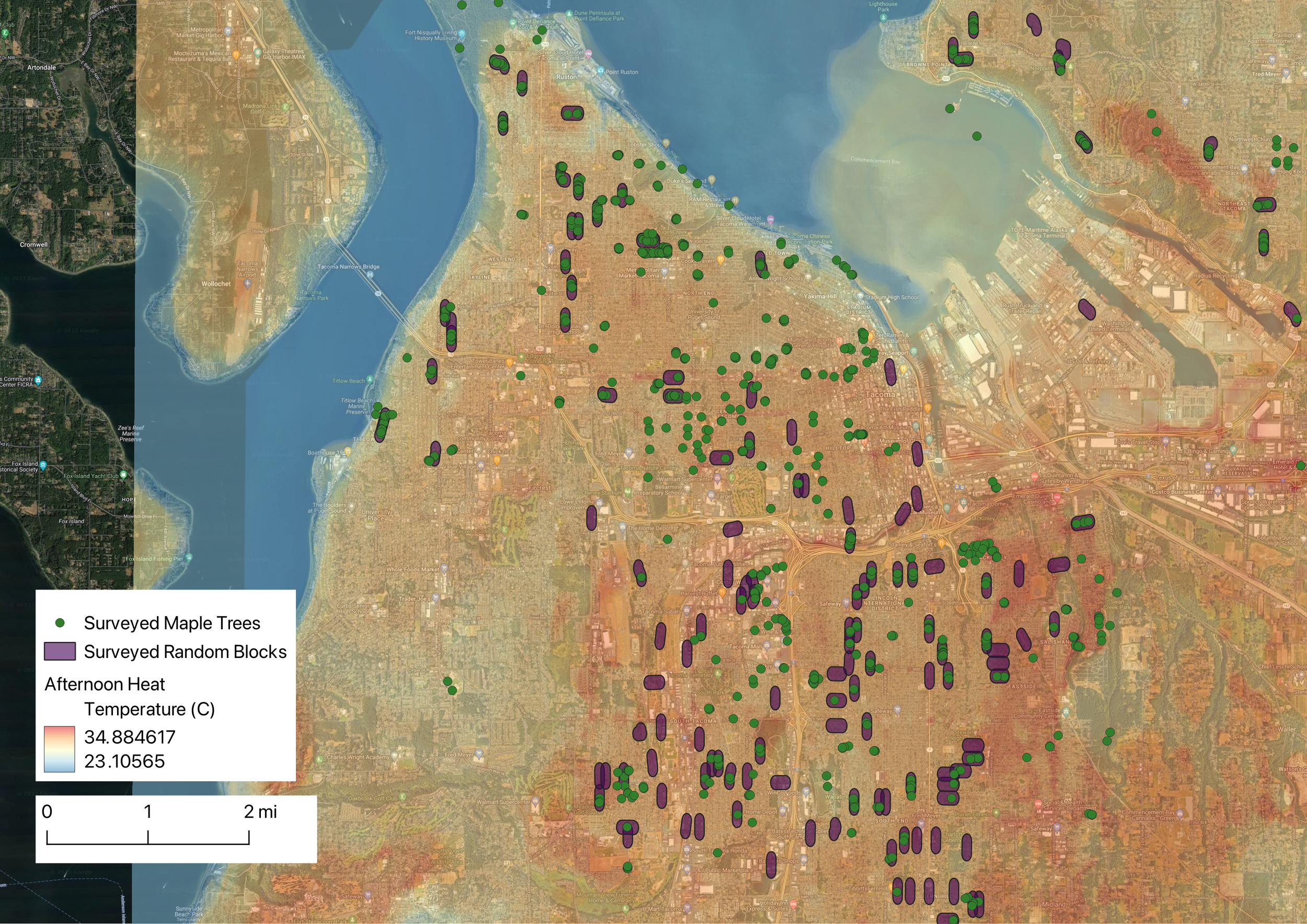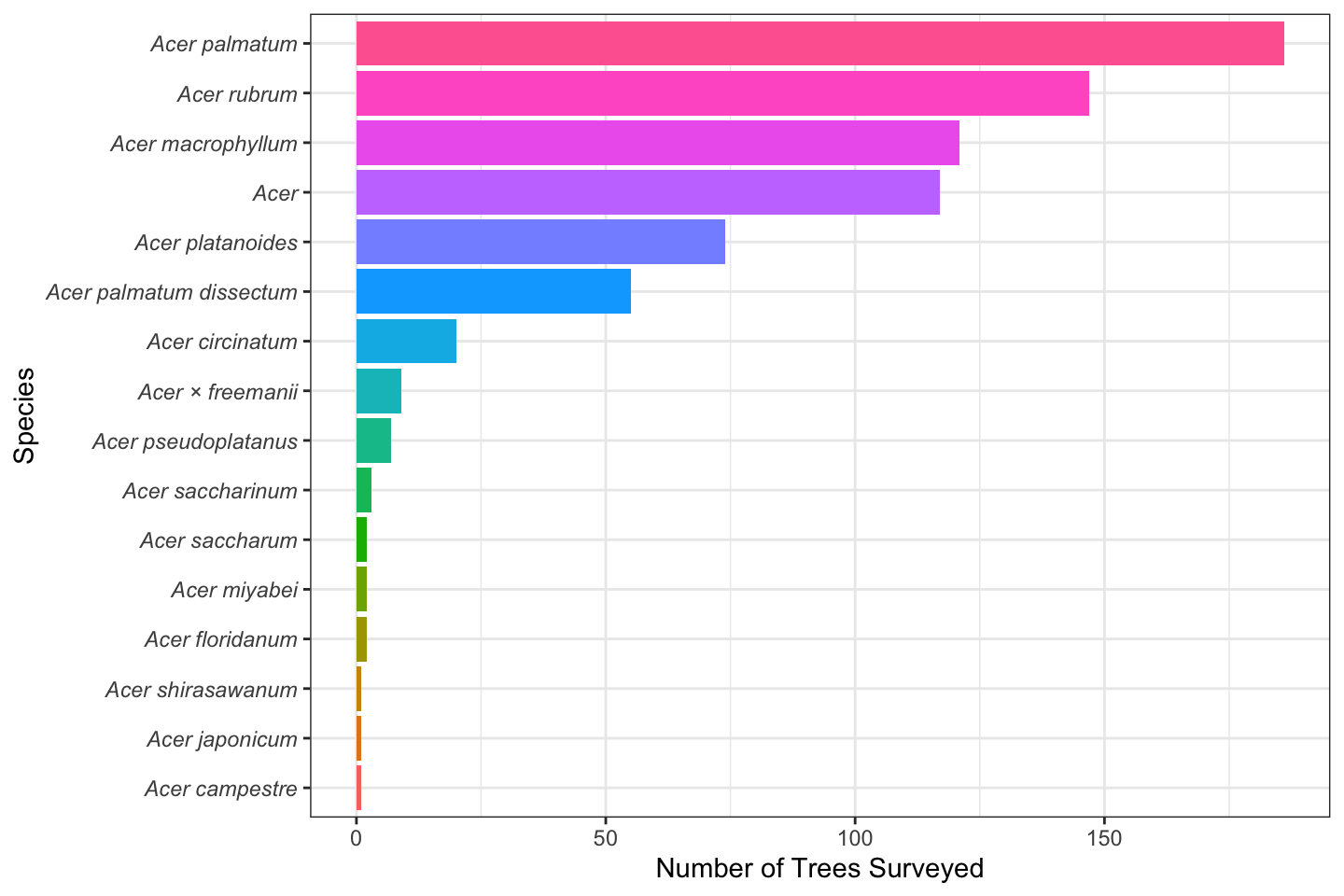Healthy maples, healthy communities
By Joey Hulbert
Does the health of our trees reflect the health of our communities?
Are trees and people vulnerable to climate change in the same way?
These are some of the questions we like to explore at the WSU Ravenholt Urban Forest Health Lab at the WSU Puyallup Research and Extension Center.
Urban Maple Trees
Maple trees are important components of our urban forest. They account for nearly a quarter of the street trees in our cities.
FIG 1. Proportions of street trees in genus Acer
These maple trees help our communities by shading our neighborhoods, cleaning our air, intercepting rain, soaking up storm water, buffering our waterways from pollution, stabilizing soils, and providing habitat.
FIG. 2. Maple trees in Wright Park
Bigleaf Maple
Bigleaf maple is native to the West Coast. It is the largest maple in the world, sometimes growing 10s of feet in diameter. We can identify Bigleaf maple by its tiny helicopter-like seeds, its enormous leaves (again the biggest of any maple species globally), and its thick mats of moss that often covers the bark completely.
While it is not typically recommended as a street tree, we can find Bigleaf maple throughout our neighborhoods and parks in Tacoma. Understanding the factors that impact Bigleaf maple in our cities is important for protecting the species in places like the Hoh Rain Forest of the Olympics.
FIG. 3 Large Bigleaf maple tree at Lake Crescent.
FIG. 4 Mossy Bigleaf maple in Hoh Rain Forest.
Bigleaf maple also has a rich cultural legacy in the northwest. Since time immemorial, wood of Bigleaf maple has been cherished for canoe paddles, containers, and tools because of its strength. Its enormous leaves were also used as temporary containers for gathering first foods and medicines. Today, bigleaf maple wood is also highly coveted by wood workers because of its beauty when spalted or figured. There is also a craft market for Bigleaf maple syrup emerging in the northwest. Considering all of these values, why wouldn’t we want to plant more Bigleaf maple in our urban forests?
Urban forest species diversity
Diversifying our urban forest increases our resiliency to the impacts of climate change and invasive species. For example, invasive insects like the Asian longhorned beetle are capable of killing most of the maple trees in our communities if introduced and left uncontrolled. Given the abundance of maple trees in our communities already, many cities have removed maples from their lists of ‘approved species to plant as street trees’ to increase urban forest diversity.
FIG. 5 Central Tacoma neighborhood planted entirely with red maple
Planting a diverse set of tree species is key to increasing the resiliency of our communities, but there are still many neighborhoods with only one species (e.g. only Norway maples). These neighborhoods may be vulnerable to issues that threaten those species.
FIG. 6. Street planted solely with Norway maple in Salishan neighborhood of Tacoma, Tree Plotter Dashboard available at https://pg-cloud.com/TacomaWA/
Maple Trees and Climate Change
Because maple trees are huge components of our urban forests (nearly one-in-four of our street trees), more research is needed to understand how climate change will affect them.
Previous research about Bigleaf maple decline found links between tree health and summer temperatures, proximity to roads, and increased development. This work was also presented in a Ravenholt Urban Forest Health Webinar.
In 2020, City of Seattle arborists also began noticing sooty bark disease on many of their maple trees (e.g. Ravenna Blcd, Beacon Ave). The Ornamental Plant Pathology program at WSU Puyallup confirmed many maple species are susceptible and the disease has been found widespread throughout western Washington.
FIG 7. Sooty bark disease on a Red maple in Tacoma.
Sooty bark disease is caused by the fungus Cryptostroma corticale.
FIG 8. Cryptostroma corticale growing in a petri plate at WSU Puyallup.
Inhaling spores of this fungus can also cause reactions in some people. We hypothesize the disease is emerging as an issue now because trees are more stressed from recent hotter and longer summer droughts and because the warmer temperatures are more favorable for the growth of the fungus. More information about the disease is available on the Forest Health Watch webpage.
Tacoma Maple Tree Health
FIG. 9: Red Maple infected with Sooty Bark Disease in Tacoma.
Because Tacoma has many communities that rely on maple trees and sooty bark disease is widespread, we applied for a Washington State Department of Natural Resources Urban and Community Forestry Assistance Grant to survey maple trees throughout Tacoma. The grant was only funded because it had support from the Tacoma Tree Foundation.
Starting in 2022, the WSU Ravenholt Urban Forest Health lab invited community members to sign up as Tacoma Community Scientists and participate in a Maple Health Watch project set up on iNaturalist. A guide for participating was also produced. Students from Highline College also participated in the project after it was integrated into an assignment in a botany class.
Maple Health Watch project on iNaturalist.
The project also funded two temporary technicians to visit 140 randomly selected blocks and survey maple trees throughout Tacoma. Maple trees were identified on 92 of the blocks, but many were not in the right-of-way. In addition, one hundred red maple trees were randomly selected from the Tacoma Tree Plotter Inventory and visited.
FIG. 11. Surveyed maple trees and random blocks in Tacoma. Urban heat data were captured by the City of Tacoma in partnership with Portland State University on July 25th, 2018.
FIG 12: Number of maple trees surveyed by species.
Most of the maple trees were healthy and very few had signs of sooty bark disease. However, more research is needed to understand the relationships between tree health and environmental factors like urban heat. Our lab continues to explore these relationships and welcome others to get involved. Please contact Joey at hulbe@wsu.edu if you’re interested in collaborating.
Get Involved
Together we can monitor and care for our urban trees to understand the impacts of climate change and invasive species. Community scientists are needed and there are many projects you can contribute to. Visit the below resources to learn more and join with other community scientists in Tacoma.
The WSU Ravenholt Urban Forest Health lab is grateful for the partnership and collaboration with the Tacoma Tree Foundation. Our tree health surveys in Tacoma could not be completed without the support of TTF. Please consider making a donation to TTF today to increase the research and growth of Tacoma’s urban forest.
Resources
Maple dieback and sooty bark disease webinars (https://treehealth.wsu.edu/recordings/
Forest Health Watch Community Scientist Network (https://foresthealth.org/scientists/)
Maple Health Watch iNaturalist Project (https://www.inaturalist.org/projects/maple-health-watch)
Maple Health Watch Field Guide (https://foresthealth.org/wp-content/uploads/2023/05/Maple-Health-Watch-Maple-Health-Watch.pdf)
Sooty Bark Disease Diagnostic Guide (https://pubs.extension.wsu.edu/sooty-bark-disease-diagnostic-guide)
Maple Bark Disease FAQ (https://doh.wa.gov/node/12614)
iNaturalist – Getting Started (https://www.inaturalist.org/pages/getting+started



